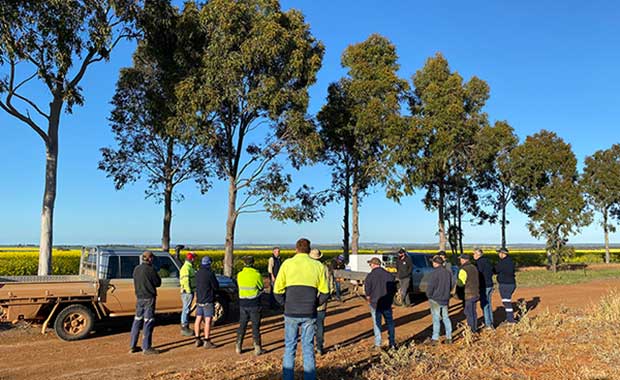Grain growers across the wheatbelt have gathered to hear the latest advice for managing mouse damage to crops this growing season at a series of in-paddock workshops with Steve Henry, leading mouse expert and research officer from Australia’s national science agency, CSIRO.
The field walks visited 11 locations across four days, from Calingiri down to Beaumont, as part of a Grains Research and Development Corporation (GRDC) investment addressing increased mouse activity in WA’s grainbelt.
Each workshop delivered regionally specific information to help growers control mice throughout the year, with significant crop damage reported in some areas of WA.
The series ran in collaboration with local industry partners and grower groups, focusing on awareness, monitoring and practical information for on-farm management.
Mr Henry’s key messages for growers across all locations were to be vigilant in late winter and early spring, complete regular checks for signs of active burrows or crop damage and be prepared to bait if damage is detected.
“In cereals this may be chewing at the node or stem, which causes the head to fall over – from a distance this can look like frost damage,” Mr Henry says.

Growers at a GRDC mouse management field walk with Steve Henry, CSIRO, in Calingiri. Image: GRDC
“In canola and legume crops, growers should be inspecting flowers and pods for damage. At the first sign of crop damage, growers need to be prepared to bait, preferably with 50g/kg zinc phosphide spread at 1kg/ha.”
Baiting efficacy was a popular topic, with a recent CSIRO mouse bait efficacy study confirming mouse populations can be reduced significantly by doubling the amount of zinc phosphide in grain baits used for broadscale agriculture.
“Baiting at the time of sowing is most effective for protecting recently sown crops, but baiting is also effective for controlling mouse damage during vegetative growth, flowering and seedset,” Mr Henry says.
“Spread baits under the best conditions possible, and if you can, ensure a three-day window before rain. If you’re going to be spending $20 per hectare on mouse baits, then you want to make sure it’s going to be effective.”
In Yilliminning, at a field walk hosted by Facey Group, grower Daniel Bird shared his experiences in mouse management this season with local growers, standing in a canola crop heavily impacted by mouse damage.
This is the first year the Bird family, who farm at Windorah Farms between Wickepin and Harrismith, have experienced mouse damage to crops.
Mr Bird says that after noticing mouse holes in the paddock and mouse damage at crop germination, they have now baited twice, using the recommended 50g/kg zine phosphide baits spread at 1kg/ha.
“We baited 1,000 hectares of crop after seeding, and then 20 per cent of that area again about six weeks later, as we noted the patches of crop damage were getting bigger,” Mr Bird says.
“The canola was planted into wheat stubble, so there would have been a lot of other food around when we baited the first time. That may have led to us having to bait a second time.
“The strip and disc system we use has also left a lot of cover on the ground, which may have contributed to available food for mice.”

A series of in-paddock workshops with Steve Henry, leading mouse expert and research officer, CSIRO, were held in 11 locations across four days as part of a GRDC investment addressing increased mouse activity in WA’s grainbelt. Image: GRDC
Mr Bird says that access to information from Mr Henry on mouse management strategies was helping to raise the profile of the issue in the wheatbelt, where mouse damage has not been as common as in the eastern states.
“This is a new issue for growers in this region, but if mouse damage in crops is going to happen across more seasons, then we need to know how to manage it.”
Group discussions from growers focused on managing mice at seeding, maximising efficacy of baiting and economic return, grazing sheep and reducing available food by minimising grain losses at harvest.
GRDC crop protection manager - west Georgia Megirian says that by working with industry partners and grower groups, GRDC’s mouse tours support a locally coordinated response to mouse management.
“The workshops provided in-paddock, seasonally relevant information to growers, with opportunities to look for signs of mouse activity and active burrows, ask questions, optimise management in their particular farming systems and learn about issues other growers are facing.
“With growing indications that mouse activity will reoccur in Western Australia in coming seasons, now is the time to get on top of this issue, and arm growers with the latest advice and management strategies to protect their grain production and their profitability.”
The mouse tours are part of GRDC’s $7.5 million national investment into mouse outbreak research, development and extension (RD&E) with CSIRO, focusing on better understanding mice in cropping systems, such as the impact of residual food in stubbles, increasing surveillance and improving strategic management options.

























































